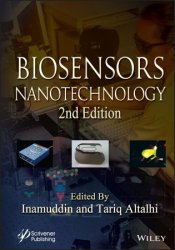Biosensors Nanotechnology, 2nd Edition
- Добавил: literator
- Дата: 12-10-2023, 00:39
- Комментариев: 0
 Название: Biosensors Nanotechnology, 2nd Edition
Название: Biosensors Nanotechnology, 2nd EditionАвтор: Inamuddin, Tariq Altalhi
Издательство: Wiley-Scrivener
Год: 2023
Страниц: 510
Язык: английский
Формат: pdf (true)
Размер: 51.5 MB
The second edition of Biosensors Nanotechnology comprises 20 chapters and discusses a wide range of applications exploited by biosensors based on nanoparticles including new domains of bionics, power production and computing.
The biosensor industry began as a small, niche activity in the 1980s and has since developed into a large, global industry. Nanomaterials have substantially improved not only non-pharmaceutical and healthcare uses, but also telecommunications, paper, and textile manufacturing. Biological sensing assists in the understanding of living systems and is used in a variety of sectors, including medicine, drug discovery, process control, environmental monitoring, food safety, military and personal protection. It allows for new opportunities in bionics, power generation and computing, all of which will benefit from a greater understanding of the bio-electronic relationship, as advances in communications and computational modeling enable us to reconsider how healthcare is offered and R&D and manufacturing are enhanced.
A field effect transistor (FET) is a device found in solid state in which the electroconductivity of the semiconductor placed between the source and drain terminals is regulated by a third electrode gate and an insulator. Despite the fact that nanostructures are produced and put into their structure to reframe their surface and boost their sensitivity, they require very little postprocessing. The source and drain electrodes are linked to the technique of immobilization of certain natural receptors such as nucleic acids, aptamers, enzymes, antibodies, cells or artificial biomaterials. When biosensors are subjected to a certain biological analyte, they produce complexes, such as immunogenic, enzyme substrate, DNA structures, and so on, which are then converted into detectable signals by the transducer system. Attaching the charged molecules to the surface of the dielectric of gate generates a voltage, resulting in cut-off voltage fluctuations. As a result, the FET biosensors approach relies on adsorbed species influencing conductance. The two basic types of FETs are n-type device and p-type device, which are distinguished by their operating principles, with electrons and holes serving as the primary charge carriers, respectively.
In this fast-evolving discipline, the combination of nanoscale materials with biosensor technology has gained a lot of traction. Nanostructures have been used to increase the adherence of biosensor materials to electrode surfaces, print nano barcodes on biomaterials, increase the pace of bio-responses, and amplify the electric signal. Some of the topics discussed in the book include: Bioreceptors for Cells; Bioreceptors for Enzymatic Interactions; Dendrimer-Based Nanomaterials for Biosensors; Biosensors in 2D Photonic Crystals; Bioreceptors for Affinity Binding in Theranostic Development; Biosensors for Glucose Monitoring; Metal-Free Quantum Dots-Based Nanomaterials for Biosensors; Bioreceptors for Microbial Biosensors; Plasmonic Nanomaterials in Sensors; Magnetic Biosensors; Biosensors for Salivary Biomarker Detection of Cancer and Neurodegenerative Diseases; Design and Development of Fluorescent Chemosensors for the Recognition of Biological Amines and Their Cell Imaging Studies; Application of Optical Nanoprobes for Supramolecular Biosensing; In Vivo Applications for Nanomaterials in Biosensors; Biosensor and Nanotechnology for Diagnosis of Breast Cancer; Bioreceptors for Antigen–Antibody Interactions; Biosensors for Paint and Pigment Analysis; Bioreceptors for Tissue; Biosensors for Pesticide Detection; and Advances in Biosensor Applications for Agroproducts Safety.
Audience:
The book is written for a large and broad readership including researchers, industry engineers, and university graduate students from diverse backgrounds such as chemistry, materials science, physics, pharmacy, medical science, biomedical engineering, electronics engineering, and nanotechnology.
Скачать Biosensors Nanotechnology, 2nd Edition
Внимание
Уважаемый посетитель, Вы зашли на сайт как незарегистрированный пользователь.
Мы рекомендуем Вам зарегистрироваться либо войти на сайт под своим именем.
Уважаемый посетитель, Вы зашли на сайт как незарегистрированный пользователь.
Мы рекомендуем Вам зарегистрироваться либо войти на сайт под своим именем.
Информация
Посетители, находящиеся в группе Гости, не могут оставлять комментарии к данной публикации.
Посетители, находящиеся в группе Гости, не могут оставлять комментарии к данной публикации.
